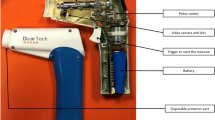Abstract
Purpose
No standardized execution or evidence demonstrates the area of the digit giving the most accurate capillary refill time (CRT). This study investigated the reliability and validity of CRT, and the relative merits of areas where the test could be performed.
Methods
In all, 127 healthy volunteers were assessed for normal CRT at the fingernail, lateral paronychia, and proximal and distal pulps of the index finger. The predictive validity of the CRT for the diagnosis of compromised vascular perfusion was also investigated on 24 subjects, using an inflated tourniquet. Three raters assessed interobserver reliability.
Results
The mean fingernail, lateral paronychia, proximal pulp, and distal pulp CRTs were 1.93, 1.78, 1.70, and 1.57 s, respectively. The tourniquet and non-tourniquet results demonstrated significant mean differences; however, the fingernail showed a subtle difference (1.22 s) compared with the proximal pulp (4.46 s). The CRT interobserver reliability was fair at the fingernail (intraclass correlation coefficient [ICC] = 0.51), but very poor in occluded limbs (ICC = 0.13). At the lateral paronychia and finger pulp, the interobserver reliability was reasonable (ICC = 0.75–0.81 [non-tourniquet] vs 0.62–0.68 [tourniquet]). In a receiver-operating characteristic curve analysis, the proximal pulp demonstrated better discrimination (area under the curve = 0.93, 95% CI 0.89–0.97, p < 0.0001); the best cutoff point was calculated to be 3 s at the proximal pulp.
Conclusions
CRT use at appropriate areas is reliable. The most dependable site is the finger pulp, and the proposed cutoff is 3 s.




Similar content being viewed by others
Availability of data and material
The datasets used and/or analyzed during the current study are available from the corresponding author on reasonable request.
References
Beecher HK, Simeone FA, et al. The internal state of the severely wounded man on entry to the most forward hospital. Surgery. 1947;22(4):672–711.
Champion HR, Sacco WJ, Hannan DS, Lepper RL, Atzinger ES, Copes WS, et al. Assessment of injury severity: the triage index. Crit Care Med. 1980;8(4):201–8.
Halvorson JJ, Anz A, Langfitt M, Deonanan JK, Scott A, Teasdall RD, et al. Vascular injury associated with extremity trauma: initial diagnosis and management. J Am Acad Orthop Surg. 2011;19(8):495–504.
Mavrogenis AF, Panagopoulos GN, Kokkalis ZT, Koulouvaris P, Megaloikonomos PD, Igoumenou V, et al. Vascular Injury in Orthopedic Trauma. Orthopedics. 2016;39(4):249–59.
Wegmann H, Eberl R, Kraus T, Till H, Eder C, Singer G. The impact of arterial vessel injuries associated with pediatric supracondylar humeral fractures. J Trauma Acute Care Surg. 2014;77(2):381–5.
Anderson B, Kelly AM, Kerr D, Clooney M, Jolley D. Impact of patient and environmental factors on capillary refill time in adults. Am J Emerg Med. 2008;26(1):62–5.
Schriger DL, Baraff L. Defining normal capillary refill: variation with age, sex, and temperature. Ann Emerg Med. 1988;17(9):932–5.
Arifin WN. A Web-based Sample Size Calculator for Reliability Studies. 2018;10:67–76.
Brabrand M, Hosbond S, Folkestad L. Capillary refill time: a study of interobserver reliability among nurses and nurse assistants. Eur J Emerg Med. 2011;18(1):46–9.
Youden WJ. Index for rating diagnostic tests. Cancer. 1950;3(1):32–5.
Fluss R, Faraggi D, Reiser B. Estimation of the Youden Index and its associated cutoff point. Biom J. 2005;47(4):458–72.
Landis JR, Koch GG. The measurement of observer agreement for categorical data. Biometrics. 1977;33(1):159–74.
Watson A, Kelly AM. Measuring capillary refill time is useless. Emergency Medicine. 1993;5(2):90–3.
El Nahid MS, El Ashmaui A. The skin microcirculatory changes in the normal and hypertensive elderly. European Geriatric Medicine. 2015;6(1):7–10.
Lima A, Jansen TC, van Bommel J, Ince C, Bakker J. The prognostic value of the subjective assessment of peripheral perfusion in critically ill patients. Crit Care Med. 2009;37(3):934–8.
Lima A, Bakker J. Clinical assessment of peripheral circulation. Curr Opin Crit Care. 2015;21(3):226–31.
Sheridan DC, Baker SD, Kayser SA, Jones D, Hansen ML. Variability of Capillary Refill Time among Physician Measurements. J Emerg Med. 2017;53(5):e51–7.
Alsma J, van Saase J, Nanayakkara PWB, Schouten W, Baten A, Bauer MP, et al. The Power of Flash Mob Research: Conducting a Nationwide Observational Clinical Study on Capillary Refill Time in a Single Day. Chest. 2017;151(5):1106–13.
Espinoza ED, Welsh S, Dubin A. Lack of agreement between different observers and methods in the measurement of capillary refill time in healthy volunteers: an observational study. Rev Bras Ter Intensiva. 2014;26(3):269–76.
Nicholas B. Vedder DPH. The Mangled Upper Extremity. In: Scott W. Wolfe RNH, William C. Pederson, Scott H. Kozin, editors. Green’s Operative Hand Surgery, 6th ed. Philadelphia: Churchill Livingstone; 2011. pp. 1603–1644.
Funding
The authors did not receive support from any organization for the submitted work.
Author information
Authors and Affiliations
Contributions
All authors contributed to the study conception and design. Material preparation, data collection and analysis were performed by Yuwarat Monteerarat and Torpon Vathana. The first draft of the manuscript was written by Yuwarat Monteerarat and all authors commented on previous versions of the manuscript. All authors read and approved the final manuscript.
Corresponding author
Ethics declarations
Conflict of interest
The authors have no relevant financial or non-financial interests to disclose.
Ethics approval
This study was performed in line with the principles of the Declaration of Helsinki. Approval was granted by the Ethics Committee of the Faculty of Medicine Siriraj Hospital, Mahidol University (Date August 14, 2014 /No Si480/2014).
Consent to participate
Inform consent was obtained from all individual participants included in the study.
Rights and permissions
About this article
Cite this article
Monteerarat, Y., Limthongthang, R., Laohaprasitiporn, P. et al. Reliability of capillary refill time for evaluation of tissue perfusion in simulated vascular occluded limbs. Eur J Trauma Emerg Surg 48, 1231–1237 (2022). https://doi.org/10.1007/s00068-020-01594-9
Received:
Accepted:
Published:
Issue Date:
DOI: https://doi.org/10.1007/s00068-020-01594-9




